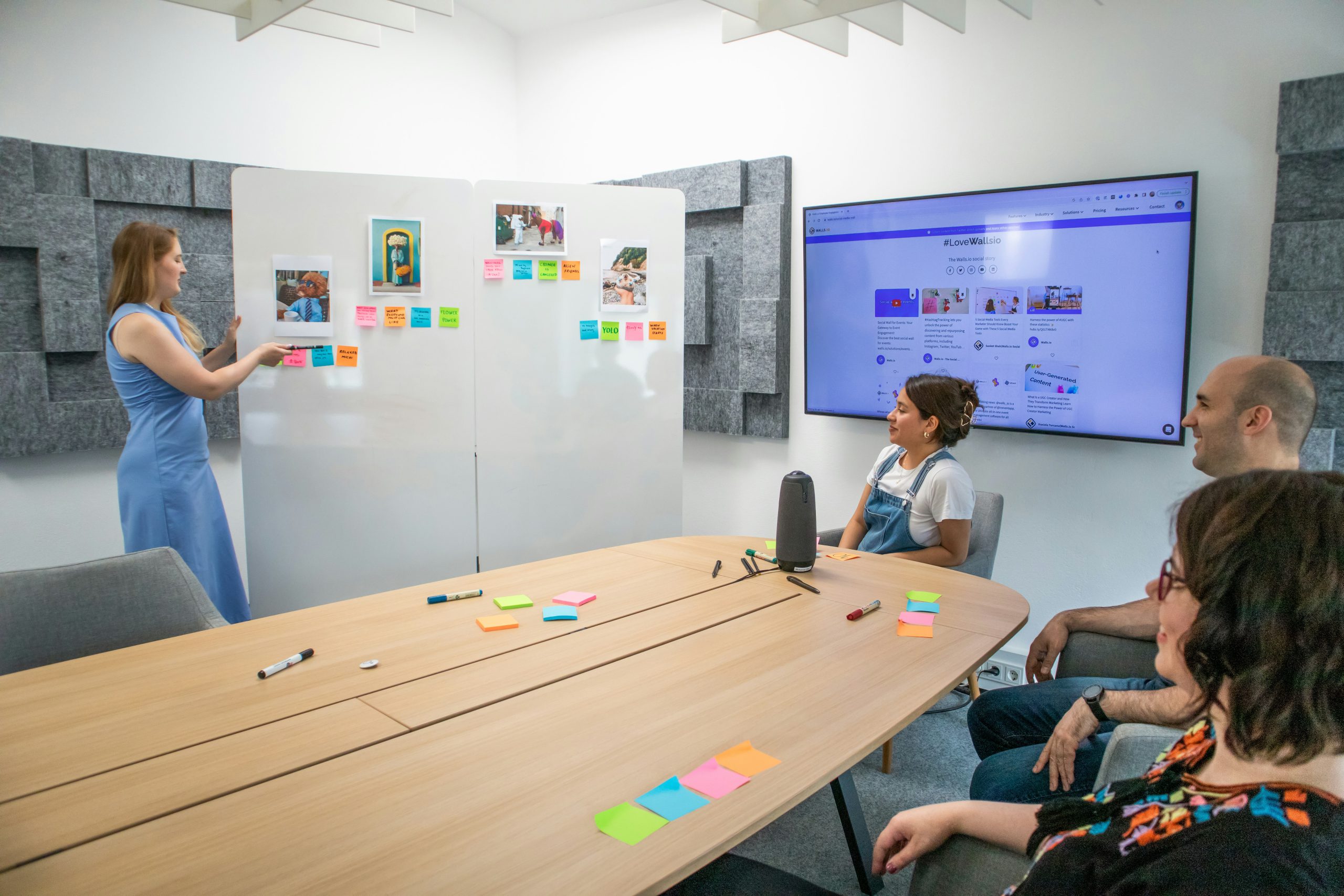Hybrid work is here to stay – about 64% of business leaders report their companies now use a hybrid model. But with employees split between offices and remote locations, managers face new challenges. In fact, 36% of leaders managing remote workers cite collaboration as their biggest hurdle.
Without daily in-person interactions, teams risk losing the trust, communication, and camaraderie that drive performance. The solution? Proactively organize team-building activities that include everyone, regardless of location. These activities break down barriers and foster unity, improving team morale, creativity, and overall performance. In this guide, we’ll share professional yet playful hybrid team building ideas – from quick icebreakers to in-depth workshops – to help your remote and on-site team members bond and thrive together.

Tips for successful hybrid team building
Planning a hybrid-friendly event takes a bit of extra thought. Keep these tips in mind to ensure everyone feels included and has fun:
- Test the tech beforehand: Verify that your video conferencing, microphones, and cameras work for both groups, and that remote participants can see and hear everyone in the room.
- Mind the time zones: Schedule activities at a time that’s reasonable for all team members, and rotate meeting times if your team spans multiple regions.
- Build in breaks: Give remote folks screen breaks just as you would pause an in-person session. A short break helps virtual attendees recharge and stay engaged.
- Keep it interactive: Choose formats that involve both remote and in-person people equally – for example, use digital tools (quizzes, polls, virtual whiteboards) so everyone can participate without feeling left out.
- Encourage equal voice: Establish ground rules so that each participant has space to speak up and be heard, whether they’re in the conference room or calling in from home.
With the logistics sorted, let’s dive into some engaging hybrid team-building activities you can try with your team.
12 fun and effective hybrid team-building activities to unite your team
Building a strong, connected team in a hybrid work environment can be challenging. With employees split between home offices and in-person workspaces, finding ways to foster collaboration, communication, and camaraderie is key to maintaining team morale and productivity.
The good news? There are plenty of creative activities that work well for both remote and in-person participants. Here are 12 fun and effective hybrid team-building activities designed to unite your team, no matter where they’re working from.
1. HIGH5 Personality test for team building
One great way to kick off team bonding is a work style test for teams that everyone takes, then discusses together. For example, you can have your team complete the HIGH5 strengths assessment in advance and then hold a session to review the results as a group.
This activity reveals each person’s key strengths and work preferences, which helps team members better understand and respect one another. After the upgrade, HIGH5 also generates a detailed Team Strengths Report analyzing your group’s collective talents and dynamics. The report provides invaluable insights, such as:
- Group Fit Score – an overall compatibility metric for the team
- Group Strengths Grid – a visual map of all members’ top strengths
- Team Strengths Culture – highlights of your team’s shared values and style
- Team Strengths Profile – a summary of dominant strengths in the team
- Team Watch-Outs – potential blind spots or areas of friction to monitor
- Team Unique Contributors – what unique value each member brings
- Workshop Presentation Template – a ready-to-use slide deck of your team’s results
- Slide-by-Slide Facilitation Guide – helps you lead a strengths discussion with talking points and activities
Sharing these results encourages teammates to use one another’s strengths and work through differences more constructively. Managers can align responsibilities with individual talents and reduce conflict. In fact, teams that adopt a strengths-based approach report significant boosts in engagement and productivity. HIGH5 users have seen a 39% increase in productivity and 74% higher employee engagement on average.
This activity is both informative and fun: colleagues enjoy “aha!” moments about each other. Team members often come away with a stronger connection and a better sense of how to collaborate.
- Time: 60–90 minutes
- Best for: Building self-awareness, understanding team dynamics, and improving collaboration
- Number of players: Any team size (ideally 4–20 for discussion)
- How to play it:
- Have all team members take the HIGH5 test before the session.
- Upgrade to unlock detailed results in the Team Strengths Report, which includes the Group Fit Score, Group Strengths Grid, Team Strengths Profile, and more.
- During the workshop, review insights using the Workshop Presentation Template and Facilitation Guide.
- Discuss strengths, team watch-outs, and unique contributors to align on how to collaborate better.
- End with action items on how to apply strengths daily.
2. Two Truths and a Lie
Kick off a meeting with a lighthearted icebreaker that works for both remote and in-person staff. Two Truths and a Lie is a classic: each person shares two true facts and one false one about themselves, and the rest of the team tries to guess which is the lie. It sparks laughter and reveals surprising stories about colleagues.
- Time: 10–15 minutes
- Best for: Icebreaking and informal bonding
- Number of players: 3–15 people
- How to play it:
- Ask each person to prepare two truths and one lie.
- Take turns sharing, while the rest guess which statement is false.
- Reveal answers and enjoy the surprises.
3. Guess Who
“Guess Who?” game. Before the session, ask team members to send in a quirky fact or a childhood photo (without revealing identities). During the activity, display each fact or photo and have everyone guess who it belongs to. For example, someone might share “I once skydived over the Grand Canyon” – can your team figure out who it is?
This guessing game is easy to run in a hybrid format. You can use slides or a chat poll for responses and help people learn amusing, personal tidbits about each other. The result is a more relaxed atmosphere and new conversation starters that bridge the distance between remote and on-site teammates.
- Time: 10–15 minutes
- Best for: Icebreaking and informal bonding
- Number of players: 3–15 people
- How to play it:
- Submit a fun fact/photo in advance.
- Take turns sharing, while the rest guess which fact/photo matches which person.
- Reveal the image or answers and enjoy the surprises.
4. “Show and tell” with personal objects
This activity lets your team members share a slice of life outside work. Each person brings an item from home that holds personal meaning and explains its story. It could be a souvenir from travels, a favorite mug, or a pet (on camera!). For instance, someone in the office might hold up a family photo they keep on their desk, while a remote worker at home might show their favorite cookbook. As each person explains why that item matters to them, colleagues get a genuine glimpse into each other’s lives beyond the job.
This simple exercise can be heartwarming and eye-opening – you’ll hear stories that spark empathy and connection. It works nicely over video conferencing (people can physically show the item on camera), and it ensures everyone, whether remote or in-person, gets a moment in the spotlight. By the end, the team will have discovered new common interests and formed stronger personal bonds.
- Time: 15–30 minutes (depending on team size)
- Best for: Building empathy and personal connection
- Number of players: 3–20 people
- How to play it:
- Ask everyone to bring a meaningful object to the call/meeting.
- Each person shows their item on camera and shares its story.
- Allow questions or short discussions after each share.
5. Hybrid Scavenger Hunt
A scavenger hunt is a high-energy way to get everyone moving and working together. It adapts well to hybrid teams. Prepare a list of items or simple tasks for participants to find and complete, some of which can be done from anywhere. Ideas might include “something red,” “your company logo,” or “a team-related inside joke item.”
During the game, in-office members can search around the workplace while remote folks search their home or surroundings. Everyone could join a video call and share a photo or description once they’ve found each item. This turns the activity into a fast-paced challenge that blends physical movement with digital interaction. Teammates might split into hybrid sub-teams, mixing remote and on-site players who communicate in real time to divide the list and cheer each other on.
A hybrid scavenger hunt not only gets people active, but also builds camaraderie as team members must think together and share some laughs (expect some goofy or inventive finds!). It’s a memorable way to unite the team toward a common silly goal, no matter where they are.
- Time: 20–30 minutes
- Best for: Energizing the group and sparking creativity
- Number of players: 5–30 (split into small teams if large)
- How to play it:
- Create a list of items/tasks (e.g., “find something red,” “snap a selfie with your pet”).
- Share the list with the team and give a time limit.
- Players search and submit photos/descriptions on Slack/Zoom chat.
- Award points and crown the winner/team.
6. Virtual Escape Room Adventure
Bring the excitement of an escape room to your hybrid team with a virtual experience. In these games, colleagues work together online to solve puzzles and complete a themed challenge. Many providers offer hybrid-friendly escape room games where some participants can be in a physical conference room while others join remotely, all looking at the same clues on their screens.
This activity is exciting and immersive, often involving a storyline (such as a mystery to solve) that unfolds as the team cracks codes and uncovers hidden hints. Success requires strong communication and teamwork. You’ll see colleagues brainstorming on a video call, dividing tasks, and helping each other through challenges under a time limit. It’s a great way to build group problem-solving skills.
By the end of the game – if they manage to escape – team members will feel a shared sense of accomplishment. A virtual escape room seamlessly blends in-person and remote collaboration, making everyone feel like they’re “in it together” despite the distance. Plus, it’s simply a lot of fun and gets the adrenaline (and competitive spirits) flowing in a friendly way.
- Time: 45–60 minutes
- Best for: Problem-solving, communication, and collaboration
- Number of players: 4–10 per escape room (can run multiple groups)
- How to play it
- Choose a provider offering virtual or hybrid escape rooms.
- Divide the team into groups and give access links.
- Solve puzzles, unlock clues, and complete the mission within the time limit.
7. Online Team Trivia Quiz
Who doesn’t enjoy a bit of trivia competition? Hosting an online team quiz is a simple way to bring everyone together, no matter where they’re working from. You can use a platform like Kahoot, Mentimeter, or Microsoft Forms to present questions and have participants buzz in answers from their phones or laptops.
Make it interesting by including a mix of general knowledge and company or team-related trivia. Think of prompts like“In what year was our company founded?” or “Which teammate once worked in Japan?” Remote and in-office members can either compete individually or be mixed into small teams in breakout rooms to confer on answers. As everyone discusses questions and tries to recall facts, camaraderie grows through friendly competition.
The quiz encourages interaction, prompts laughter, and creates space for team members to show strengths that don’t always come through in day-to-day tasks. Keep the tone light and celebrate humorous wrong answers to maintain the playful vibe. At the end, you can crown a trivia champion or winning team – perhaps with a fun prize or just bragging rights. The real win is that the group has shared some laughs and learned new tidbits, reinforcing team spirit.
- Time: 20–30 minutes
- Best for: Friendly competition and knowledge sharing
- Number of players: Any size (best in groups of 5–20)
- How to play it:
- Prepare trivia questions (mix of general and team/company trivia).
- Use Kahoot, Mentimeter, or Zoom polls to collect answers.
- Play individually or in breakout groups.
- Keep score and announce winners.
8. Virtual Game Night
Organize a hybrid game night where colleagues can unwind with classic party games adapted for both remote and in-person play. For example, try Pictionary: use an online whiteboard or Zoom’s built-in version. Players take turns drawing while others guess in real time, no matter where they are.
For Charades, the person acting can stand on camera for remote colleagues and in front of the room for those on-site, acting out a phrase or movie title while others guess. Games like Taboo, Scattergories, or a quick virtual Bingo are also great options.
These familiar games encourage laughter, creativity, and friendly competition. They offer a simple way to bring everyone together and support better team interaction. Whether acting, drawing, or describing, participants practice quick thinking and clear communication.
Whether someone is participating via webcam or in person, everyone is equally part of the action. A virtual game night lets your team relax and show their silly sides, helping to strengthen relationships and create lasting shared memories beyond work tasks.
- Time: 30–45 minutes
- Best for: Laughter, creativity, and breaking routine
- Number of players: 4–20
- How to play it:
- Pictionary: Use an online whiteboard. Players draw, others guess.
- Charades: One person acts while others guess.
- Bingo: Send out digital cards; call out words until someone wins.
9. Virtual Coffee Breaks and Happy Hours
Not every team interaction needs to be a structured game. Sometimes the best connections happen during casual chats over coffee or a drink. Encourage regular hybrid social breaks, such as a mid-morning virtual coffee catch-up or a relaxed Friday afternoon happy hour.
Start a simple video call and set up a meeting room screen for those in the office, so everyone can join in. Let the conversation flow around weekend plans, hobbies, or recent Netflix binges. It might feel simple, but it addresses a big gap in hybrid work life: we all miss those spontaneous watercooler chats and hallway jokes when working apart.
Managers may need to plan these intentionally, but they’re worth the effort. Remote coffee breaks are a great way to encourage connections and mimic the camaraderie of office life. For happy hours, you can even have fun themes (like a trivia mini-game, a costume day, or a make-your-own-cocktail demo) to give the event some structure without forcing it.
The key is inclusivity. Ensure remote team members can see and hear side conversations, and prompt in-person team members to bring their laptops around if they break into smaller, chit-chat circles. These casual touchpoints enable colleagues to connect on a personal level, rather than just as teammates. That familiarity builds trust, which carries over into better collaboration during work hours.
- Time: 15–30 minutes
- Best for: Informal socializing and team bonding
- Number of players: Any team size
- How to play it:
- Schedule casual “drop-in” sessions.
- Use video call for both office and remote participants.
- Encourage informal conversation, or add a light theme/topic if needed.
10. Hybrid Fitness Challenge
Bring some healthy competition into the workplace by setting up a hybrid fitness challenge that includes both remote and on-site employees. The format can vary based on your team’s preferences. One popular approach is a step or exercise challenge, where participants track steps, miles, or workout minutes over a set period. Participants can use fitness apps or wearable trackers and sync their progress to a shared leaderboard.
You can create mixed teams with both remote and in-office members, or have individuals pursue personal targets. This type of challenge encourages physical activity and friendly rivalry while keeping things inclusive. It combines physical well-being with team bonding – as colleagues cheer each other on in a group chat or share post-workout selfies, they build camaraderie and positive vibes.
Meeting fitness goals together also fosters a sense of collective accomplishment that translates to the workplace, promoting determination and support in achieving team goals. To keep things fresh, expand beyond step counts. Include daily yoga sessions on video, a cycling goal, or a group meditation streak. Wellness isn’t limited to movement—mental clarity matters too.
Be sure to celebrate milestones and recognize the effort of participants, not just the top performers. A hybrid fitness challenge supports health, builds team spirit, and keeps motivation high across the board.
- Time: Ongoing (daily/weekly for 2–4 weeks)
- Best for: Promoting wellness, motivation, and accountability
- Number of players: Any team size (works best with sub-teams of 3–5)
- How to play it:
- Decide on a challenge (e.g., steps, miles, or active minutes).
- Use a shared tracker or app (e.g., Strava, Fitbit, or Google Sheets).
- Share progress, celebrate milestones, and reward achievements.
11. Shared Team Playlist (Music show-and-tell)
Music is a powerful connector, so why not harness it for team building? Creating a shared team playlist is a simple yet creative hybrid activity. Start by picking a theme – it could be “Songs to Energize Us on Monday Mornings” or just everyone’s current favorites. Each team member, whether remote or on-site, adds one or two tracks to a shared playlist on platforms like Spotify, Apple Music, or YouTube. Then, schedule a short session where everyone comes together (via video call and in the office) for a music show-and-tell.
Everyone can explain their song choice and what it means to them, and then play a snippet for the group. These conversations often reveal unexpected sides of colleagues and spark genuine interest in each other’s tastes. The process of sharing music fosters collaboration and a shared sense of creativity among team members. It’s also very inclusive, giving everyone an equal opportunity to share and participate, no matter where they’re based.
After your music session, you’ll have a unique team playlist that reflects the team’s personality. It can be played during the workday as a casual reminder of shared moments and conversations. Whenever a song from the playlist comes on, people will be reminded of their colleagues and that fun discussion (“This is Alice’s pump-up jam!”). It’s an easy, feel-good way to build team culture across distances.
- Time: 15–20 minutes (initial session), playlist ongoing
- Best for: Cultural bonding and sharing personality through music
- Number of players: Any team size
- How to play it:
- Pick a theme (e.g., pump-up songs, favorite work jams).
- Each person contributes one or two tracks to a shared playlist.
- Host a short session where participants explain their picks.
- Share the playlist link for everyone to enjoy afterward.
12. Virtual Talent Show or Creative Showcase
Give your team a chance to shine beyond their usual work roles by hosting a virtual talent show or creative showcase. This can be an informal event where team members volunteer to share a talent, hobby, or project they’re passionate about.
Some may choose to perform live during a video call or in front of a hybrid audience. That might include music, singing, comedy, or a quick magic trick. Others might prefer sharing something prepared in advance, such as artwork, photography, a video they’ve made, or even a skill demo like a cooking segment or short language lesson.
For a less performance-focused twist, you could also do a “team art show” where everyone brings a drawing, craft, or design to share. The key is to encourage a variety of contributions and ensure a supportive, no-pressure atmosphere.
As colleagues reveal their hidden talents and interests, it often sparks genuine conversations and appreciation. Team members see new sides of each other and celebrate each person’s uniqueness. This activity transcends work titles and distances: a remote teammate can wow everyone with a piano solo from their living room, while an office-based colleague might screen-share their latest photography.
These events often end with laughter, applause, and a sense of pride. It reinforces that your team is made up of diverse, talented individuals and creates lasting memories of cheering each other on.
- Time: 45–60 minutes
- Best for: Celebrating individuality and encouraging team appreciation
- Number of players: 5–15 performers, larger audience welcome
- How to play it:
- Ask volunteers to sign up and prepare a short act (live or pre-recorded).
- Host the event on Zoom or in a hybrid meeting room.
- Encourage applause, positive comments, and a fun atmosphere.
- Optionally, give lighthearted awards (e.g., “Most Surprising Talent”).
Conclusion
Building connections in a hybrid team takes creativity and initiative. With the right activities, you can bridge the gap between remote and on-site colleagues while enjoying the process. A game, shared challenge, or meaningful discussion can each strengthen trust, creativity, and camaraderie. Over time, those fun moments build stronger working relationships and better collaboration on the job. It’s more than just team games; it’s about creating real, lasting bonds that support a healthier and more successful team dynamic. So go ahead and try some of these activities with your team. Supporting both the professional and social sides of teamwork helps everyone feel involved, motivated, and aligned. Cheers to a more connected hybrid team!
FAQ
What makes an activity hybrid team-friendly?
A hybrid-friendly activity includes both remote and in-person participants equally. It uses tools or formats that allow everyone to engage, contribute, and feel involved regardless of location. This means using tools like video calls, collaborative apps, or shared documents that let everyone engage in real time. It’s also helpful to use formats that don’t rely on physical presence—so each participant can contribute meaningfully, whether they’re in a meeting room or working from home.
How often should we plan hybrid team-building activities?
Once a month is a good baseline for most teams, but the ideal frequency depends on your team’s size, structure, and workload. Some groups benefit from weekly mini-activities like casual chats, while others thrive with less frequent but more in-depth sessions. Spacing activities out too much can lead to disconnection, especially if most of your communication is work-related. A consistent rhythm—without overwhelming the calendar—keeps people engaged.
Can small teams benefit from these activities too?
Absolutely. In fact, smaller teams may find it easier to build deeper connections quickly. Most of the listed activities scale down well, allowing for more personal interaction. These sessions also help new or quiet team members feel more comfortable speaking up. Even a 10-minute activity can make a lasting difference in how a small team works together.
Do we need a budget to run these activities?
Many activities, such as icebreakers, trivia, or “show and tell,” require little to no budget. Others, like escape rooms or classes, may involve costs but you can choose options that match your resources. The key is to balance cost with impact and keep things inclusive. Even small gestures, like prizes or snacks for both remote and in-person teammates, can add value.
What if some team members don’t want to participate?
It’s important to keep activities optional and low-pressure. Encourage participation through variety and inclusion, but don’t force it. Keep the tone light and offer a range of activities so people can choose what suits them. Over time, people often join in once they see the value and fun.




